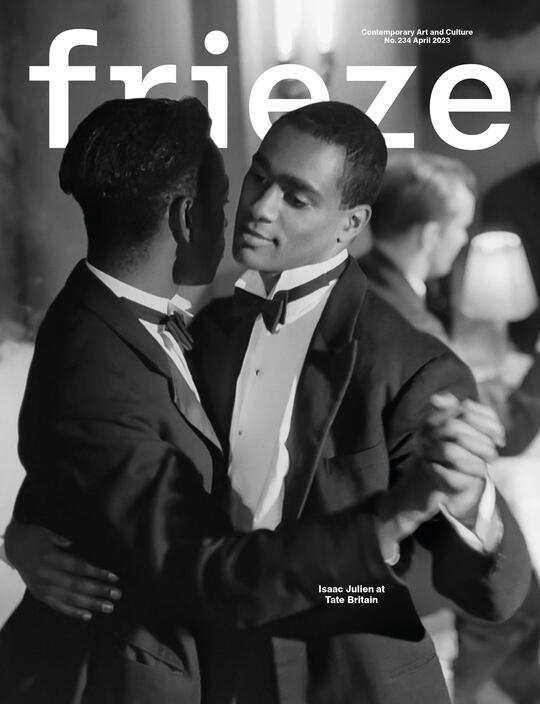Renée Stout Wields Illegibility as a Form of Resistance
An exhibition of recent work at Marc Straus, New York, draws on diasporic African religious customs and personal mystery
An exhibition of recent work at Marc Straus, New York, draws on diasporic African religious customs and personal mystery

The fragmented phantasmagoria of ‘Navigating the Abyss’, Renée Stout’s show of recent work at Marc Straus gallery, mingles spirituality and political terror. The 65-year-old artist’s previous exhibitions employed a cast of fictional alter-egos to guide us through her singular world. While ‘Navigating the Abyss’ includes a colourful acrylic of longtime avatar Fatima Mayfield as part of a frank and moving series of portraits titled ‘Hoodoo Assassins and Agents’ (Hoodoo Assassin # 5 (The Lieutenant), 2019), Stout’s new body of work fosters logical gaps, knowing that both art and hope grow in the cavities of rational thought. The 33 pieces on display – spanning painting, drawing, sculpture and mixed media – are dense with hidden knowledge, enduring traditions and personal enigma.

Stout has a scholarly streak but, more importantly, a knack for political, feminist subversions. Central to her practice is Hoodoo, a set of religious practices that diasporic Africans observed secretly as slaves in the Americas. While her ‘Fetish’ series of the late 1980s and early ’90s saw Stout adorn fabricated divine Central African minkisi figures with unorthodox, personal accoutrements, here, she doctors an object from another region to different ends. Ikenga (If You Come for the Queen, You Better Not Miss) (2022) is a rare female example of the titular Nigerian statue, customarily used by Igbo people to memorialize major achievements. Stout constructs her trenchant recontextualization from a found artifact manufactured for tourists, cutting off its horns and fashioning them into gun barrels, attaching handcuffs to its waist and affixing to its back a nondescript metre that resembles a jetpack. The result is an armed defender of women and people of colour. Indeed, Stout’s immersion in Hoodoo stems partially from an interest in contemporary applications of syncretic African traditions: Black people and women continue to battle varieties of enslavement in 2023, and she implies that their resistance isn’t just urgent – it also must be undertaken covertly.

The combination of figuration, text and abstract blots of neon colour in Stout’s paintings evokes the Hairy Who, a late-1960s group of Chicago painters who embraced flamboyant hues and cartoonish overstatement. Yet, an opposite tendency can also be found in her art. Time to Smite Some Asses (The Fixer) (2022) and the gorgeously crowded collage The Learning (2022) – featuring a disparaging rendering of US Republican Senate Leader Mitch McConnell – are both just 15 centimetres tall, collapsing her predecessors’ grand gestures into a space that feels intimate, like sketches a teenager hides from her teacher between the pages of a spiral notebook. Her series of five tiny acrylics, ‘Visions of the Fall, in Thumbnails’, might be abstractions or divinations of earthly cataclysm and celestial landscapes. Regardless, the depth of the wood blocks on which they’re painted – Stout favours panels, ledger sheets and handmade paper – evince a dimension beyond the paintings’ surface. The works’ miniscule size suggests an apocalypse viewed at comfortable remove, perhaps from the porthole of a spaceship floating through the safety of a far-flung universe.

Stout’s obfuscation extends to both her work’s display and our inability to understand the entirety of her content. Ghost Book (to the Memory of a Man I Will Forget) (2022) is mounted backwards, its smear of white facing the wall. Bordering The Seer Had a Vision (2022) are a list of inscrutable numbers – addresses to which Stout is considering moving, though the viewer can’t impute this meaning. And the harrowing sculpture American Memory Jar (2022) comprises a glass jug filled with cotton stems, its fraught fibres entirely obscured by mortar, toy guns and a baby doll’s head. Stout demonstrates that legibility to an audience is only one reason for art-making: her dominant motivation is protecting selfhood from those who may diminish it. ‘Navigating the Abyss’ bursts with strong convictions and maximalist compositions, but also touts the obverse quality of concealment: this, after all, is how rituals must be practiced in dangerous times.
‘Renée Stout: Navigating the Abyss’ is on view at Marc Straus, New York, until 5 March.
Main image: Renée Stout, Time to Smite Some Asses (The Fixer), 2022, acrylic on wood panel, 15 × 15 cm. Courtesy: the artist and MARC STRAUS, New York





















